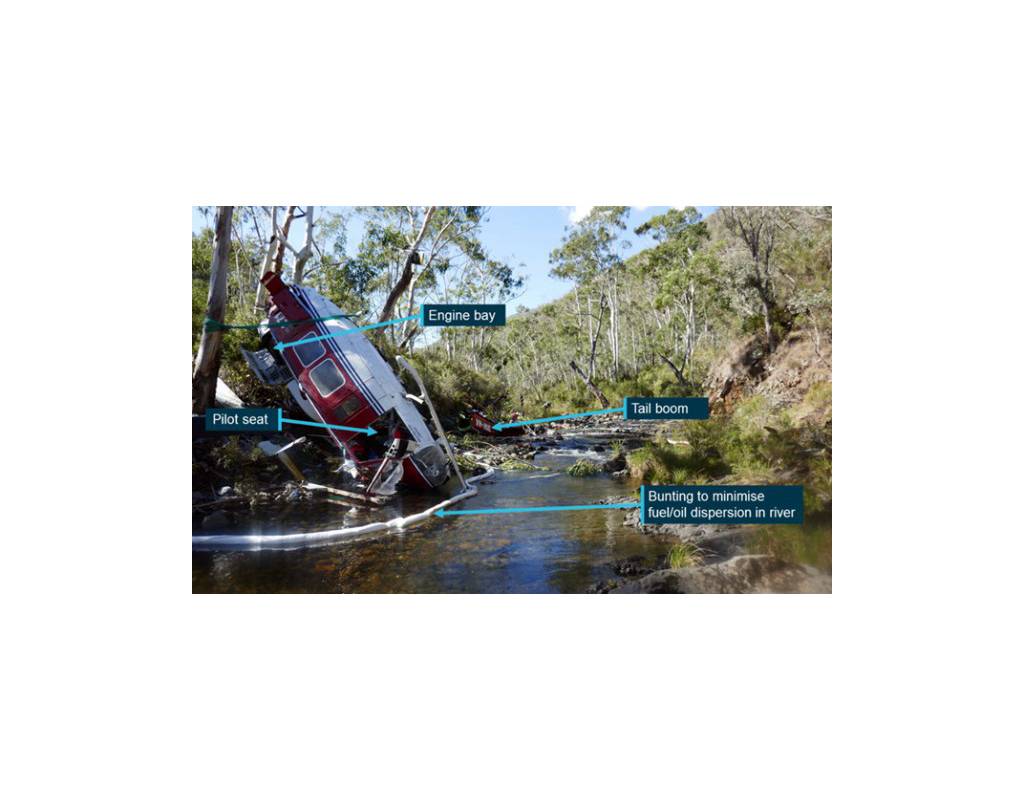
Aerial firefighting and long-line lifting helicopter pilots are often subjected to an elevated risk of serious injury, as standard upper torso restraints are not suitable for use during many of these operations, an Australian Transport Safety Bureau investigation highlights.
On 17 April 2018, the pilot of a Garlick Helicopters UH-1H ‘Huey’ helicopter, was conducting long-line lifting operations near Talbingo, in the Snowy Mountains region of New South Wales, to assist drilling works for the Snowy 2.0 project.
After 11 uneventful lifting runs between a drill site and a laydown area, the pilot was climbing clear of trees near the drill site, waiting for the next load to be ready.
As the helicopter started to climb, the pilot heard a loud mechanical ‘screaming’ noise and started planning for a forced landing. Witnesses also reported seeing ‘smoke’ and some advised they heard a ‘bang’ at about the same time.
Almost immediately, the pilot also heard an audible alarm, then experienced noticeable yaw and engine power loss.
Unable to determine if ground crew would be clear of the helicopter at the drill site clearing, the pilot opted instead to conduct the forced landing in the nearby Yarrangobilly riverbed to the south-west.
The helicopter subsequently collided with trees and the riverbed, and was destroyed. Ground personnel from the drill site immediately responded to the accident, extinguishing a small fire in the engine bay and removing the pilot from the wreckage.
The pilot was wearing a lapbelt and a helmet, but was not wearing the fitted upper torso restraint.
“It was virtually certain that this lack of upper torso restraint use resulted in the pilot sustaining serious head injuries when the aircraft collided with the riverbed,” ATSB Director Transport Safety Dr Stuart Godley said.
In Australia, vertical reference flying – when a pilot looks down as well as out to position the helicopter – mainly comprises aerial firefighting, and to a lesser extent, lifting operations.
During the ATSB investigation, it was identified that a notable proportion of pilots conducting vertical reference flying operations are likely not routinely wearing upper torso restraints.
“In the majority of helicopters used for vertical reference flying, the pilot often needs to be able to lean out to look below the helicopter to observe the line and load,” Dr Godley said.
“Standard upper torso restraints are likely not fit-for-purpose for these operations. This means, in the event of an accident, the restraints cannot provide the important defence to reduce the severity of injuries.
“Engineering innovations for these restraints could reduce the risk associated with this problem, which is particularly relevant in Australia during bushfire season, when the frequency of vertical reference flying is elevated.”
During the examination of the wreckage at the site, the ATSB identified cracking and material loss visible in the exhaust diffuser area.
The helicopter’s engine was sent to the manufacturer’s facilities in the United States, where it underwent a teardown examination.
“This examination revealed extensive fatigue cracking in the exhaust diffuser inner struts, which supports the rear of the power turbine assembly,” Dr Godley said.
“When these fatigue cracks led the engine exhaust diffuser inner struts to fracture, this resulted in a complete loss of engine power.”
It was determined this high-cycle metal fatigue had not been detected for at least 34 daily, and 2 phased maintenance inspections prior to the accident.
Although the helicopter’s engine failed close to the cleared drilling area, the pilot did not have assurance that ground support personnel could vacate the drill site in an emergency.
The ATSB found that the documented risk assessment for the helicopter’s lifting operations at the drill site operations did not consider the hazard of an emergency landing.
“This increased the risk that ground personnel were not clear of the load pick-up area in the event an emergency landing was required. In this accident, this lack of assurance led the pilot to conduct the forced landing to a less suitable location, increasing the severity of impact forces during the subsequent collision with terrain,” Dr Godley said.
Read the report: AO-2018-031 Collision with terrain, Garlick Helicopters UH-1H, VH-HUE 24 km south-east of Talbingo, New South Wales, on 17 April 2018
This press release was prepared and distributed by the Australian Transport Safety Bureau.



